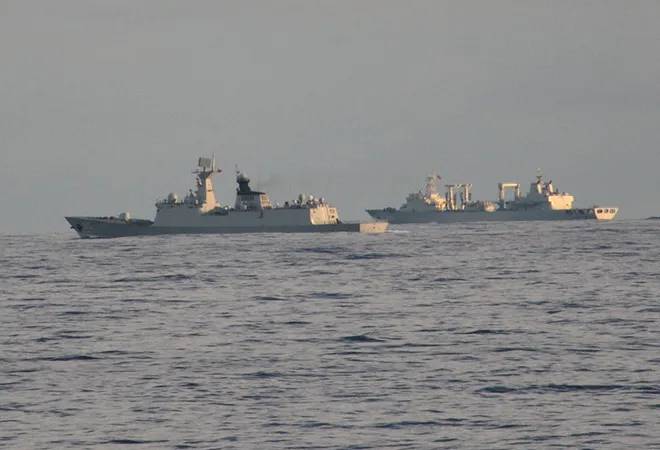It seems quaint that a recent proposal to combat piracy and armed robbery in the Indian Ocean has come from Sri Lanka. The island state, after all, hasn’t faced too many armed robbers or pirates in its littoral seas. While Colombo has had a persistent illegal fishing problem in its waters, it isn’t the kind that would need a pan-Indian Ocean agreement to effectively tackle. And yet, Sri Lankan policymakers and foreign policy observers have, over the past year, been the most strident advocates of Codes of Conduct in the Indian Ocean Region, which many in Colombo believe is on the brink of an unprecedented security crisis.
In January 2018, the Pathfinder Foundation, a Sri Lankan think tank, drafted a codes of conduct (CoC) for the Indian Ocean to be submitted to the Indian Ocean Rim Association (IORA). Prepared ostensibly at the behest of the Sri Lankan government, the codes is a non-binding document that seeks to prescribe “rules to be observed in organizing co-operation in the pursuit of a common set of objectives” in the regional commons. Regrettably, despite ticking all the right boxes—calling for greater information sharing among regional partners; for signatories to establish a single point of contact for maritime matters; and for the need to strengthen intra-regional communication and collaboration—the CoC falls short of credibly addressing the Indian Ocean’s many complex non-traditional challenges.
The codes are problematic at many levels. To start, it appears odd that Colombo should try and address security challenges not in “South Asia”— where Sri Lanka is located—but the “Western Indian Ocean”, where there is already a functioning pact. The fact that piracy off Somalia is at its lowest ebb suggests the extant codes have worked well. The Sri Lankan draft codes offers no reasons why the former must be replaced (or supplemented with)a more overarching and less comprehensive set of guidelines.
More pertinently, the substantive articles in Colombo’s CoC lack content and clarity, struggling outside of a few key topics. Not surprisingly, beyond piracy (art. 6), armed robbery against ships (art. 7), and illegal, unreported, and unregulated (IUU) fishing (art. 8), little else is effectively covered. While issues like transnational crime and maritime terrorism get a cursory mention in Article 2, there is no real attempt to outline a remedial mechanism. Nor does the draft offer substantive solutions for trafficking or smuggling, both significant threats in South Asia.
This is not to say the document is wholly lacking in purpose. Its framers laudably attempt to address the issue of insufficient operational coordination. Articles 9-15 of the draft codes detail various aspects of regional cooperation, and Articles 16-21 provide clauses to ensure no prejudice to applicable law. Yet the text seems limited in scope, creating the sense of a perfunctory attempt at addressing complex regional challenges, in particular the need to evolve mechanisms that optimize resources and effort.
The main issue with the codes is that it isn’t about human security threats at all, but regional geopolitics. The document is a prelude to a more wide-ranging agreement on the Indian Ocean as a Zone of Peace (ZOP)—an idea that has animated Sri Lanka’s foreign policy establishment since 2014, when China began expanding its strategic footprint in South Asia. Its real motivation is outlined in the introduction, which recalls an address by Sri Lanka’s prime minister Ranil Wickremesinghe calling on regional states to abide by the 1971 UN General Assembly resolution “banning Great Power rivalry from the Indian Ocean” and setting the region aside as an Indian Ocean “Zone of Peace”.
But the idea of a ZOP is inherently problematic. As TP Srinivasan, India’s representative to the Ad Hoc Committee on the Indian Ocean in the early 1980s, pointed out in 2015, the 1971 proposal wasn’t as much about peace and tranquility as it was about circumscribing the presence of Western powers in the Indian Ocean. Its contentious clauses bitterly divided members of the Ad Hoc Committee, leading to a suspicion in some Indian quarters that Sri Lankan maritime policy was driven not by the fear of extra-regional presence but with Indian naval power—on the ascendant after the attack on Karachi harbor in December 1971. Many in New Delhi felt the Indian Ocean ZOP was an attempt by Colombo to buy insurance against possible Indian designs on Sri Lanka.
This is not to accuse Sri Lankan analysts of strategic cunning. Under the circumstances that prevail in South Asia, a ZOP in the Indian Ocean seems a desirable proposition. Indeed, China’s increasing presence in South Asia and the western Indian Ocean and the naval activities of other major powers create an imperative to limit international military presence in the region. Yet, instead of curbing external military activity in the IOR, the CoC might only end up curtailing the strategic agency of the regional players. Worse, since it does not attempt to strengthen understanding or enforcement of existing rules and norms in the UN Convention on the Law of the Sea (UNCLOS)—which China has been charged with blatantly violating—the codes might embolden the Chinese navy to continue with its aggressive expansion in the regional commons. The belief that military activity in a critical maritime space can be restricted by simply declaring it a restricted zone for military activity can only be described as strategic naiveté.
More worrying is Prime Minister Wickremesinghe’s suggestion that existing international rules such as the UNCLOS may be outdated and no longer applicable to today’s global political order. While the codes itself reaffirms UNCLOS as a foundational document, it seeks to establish a new regional order that deviates from the established global order based on UNCLOS and related multilateral maritime security agreements—a redline for most other Indian Ocean states.
Unfortunately, India’s response to the ZOP has been muddled. The government of Prime Minister Narendra Modi initially welcomed the idea, with National Security Adviser Ajit Doval openly endorsing it during the 2014 Galle Dialogue in Colombo. Evidently, an influential section of India’s political elite at the time regarded both Chinese and U.S. naval power in South Asia with some suspicion. Lately, however, a realization has dawned that the Indian Navy lacks the capacity to counter the Chinese footprint in the IOR. Now more than ever, Indian policymakers realize the need for a favorable balance of power in maritime Asia, for which a deeper association with the United States is a strategic pre-condition. Despite its “in-principle” support for a ZOP, therefore, New Delhi is likely to oppose the proposal in practice.
Another concern for New Delhi is that talk of a ZOP may lead Pakistan to raise the pitch for a denuclearized Indian Ocean—a proposition first mooted in the aftermath of India’s nuclear test in 1974, and one that New Delhi has strongly resisted. The Pakistan Navy has no clear need for a ballistic missile-capable submarine, as it is not bound by a “no-first use” policy. Islamabad, however, is intent on countering India’s own ballistic missile submarine, which Pakistani military experts say has skewed the balance of power in the Indian Ocean. As a preliminary measure, the Pakistan navy has invested in a naval tactical missile capability, which it recently tested. In the unlikely event that the Indian Ocean is declared a denuclearized ZOP, India fears Pakistan wouldn’t actually remove its naval tactical nuclear weapons because of the impracticality of differentiating such weapons from regular armament mounted on conventional platforms. New Delhi, on the other hand, would need to take its ballistic missile submarine out of the equation, losing its only survivable deterrent in the Indian Ocean.
The biggest worry for Indian observers is that the ZOP would impose few practical restrictions on China. Beijing will be happy to sign up to a document that prohibits the use of ships and aircraft against the littoral and hinterland states, if the rights of “free and unimpeded passage” of such platforms are protected. And while Beijing mightbe prohibited from setting up full-fledged military bases in the IOR, it will be free to have its dual-use facilities in Gwadar, Hambantota, Colombo, and Maldives. In effect, the ZOP will allow China to continue with its strategy of incremental expansion in the IOR, while curbing India’s activism in its own backyard. Indian analysts note the irony of China being expected to abide by the rules of a compulsory CoC in the Indian Ocean, when Beijing has been dragging its feet on the more urgently needed pact in the South China Sea. In effect, the Zone of Peace would do little to resolve the Indian Ocean’s strategic complexities.
This commentary originally appeared in The Asia Maritime Transparency Initiative.
The views expressed above belong to the author(s). ORF research and analyses now available on Telegram! Click here to access our curated content — blogs, longforms and interviews.




 PREV
PREV


